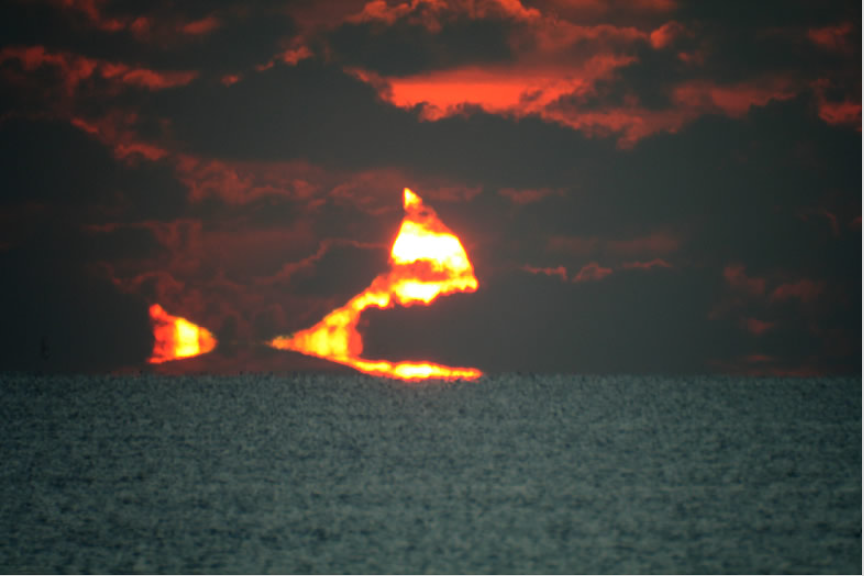Eclipsed "Omega" Sunrise, French Guiana
Eclipsed "Omega" Sunrise: A Phenomenon in French Guiana
Have you ever witnessed a sunrise that looked like an upside-down dark hourglass? If not, then you're in for a treat. On September 22nd, 2006, Michael Gill from Birmingham, England captured a mesmerizing image of a partially eclipsed sun in Kourou, French Guiana. This extraordinary optical phenomenon, known as the "omega" mirage, left spectators in awe.
The photograph taken by Gill showcases a peculiar shape resembling an inverted hourglass. What makes this image even more fascinating is that it provides evidence that one of the solar images in an "omega" sunrise mirage is indeed upside-down. To fully comprehend the mechanics behind this captivating phenomenon, let's delve deeper into its explanation and explore additional images.
An "omega" sunrise mirage occurs when light rays passing through different layers of the atmosphere are bent or refracted, resulting in the formation of distorted images. In this case, the partial eclipse adds an extra layer of intrigue to the spectacle. As the sun rises, its rays pass through atmospheric layers with varying densities and temperatures. These atmospheric conditions cause the light to refract and bend, leading to the creation of multiple images of the sun.
In the case of the "omega" mirage, two primary images of the sun are formed. One image appears above the horizon, while the other appears below. The upper image appears normal, while the lower image is inverted due to the bending of light rays. This inverted image gives rise to the distinctive dark hourglass shape seen in Gill's photograph.
The atmospheric conditions required for the formation of an "omega" sunrise mirage are quite specific. It typically occurs when there is a significant temperature inversion, where a layer of warm air lies above a layer of cooler air near the surface. This inversion causes light rays to curve downward, leading to the creation of the inverted image. The shape of the mirage can vary depending on the specific atmospheric conditions and the angle at which the sun's rays pass through the layers.
It is worth noting that "omega" sunrise mirages are relatively rare and require specific atmospheric conditions to manifest. Therefore, capturing such a phenomenon on camera, as Michael Gill did, is a remarkable achievement. His photograph not only showcases the beauty of this optical illusion but also provides valuable insights into the physics behind it.
The "omega" sunrise mirage is just one example of the captivating atmospheric optics phenomena that can occur in various parts of the world. From halos and rainbows to mirages and iridescence, our atmosphere never fails to surprise us with its ability to create stunning visual spectacles. Exploring these phenomena allows us to gain a deeper understanding of the intricate interactions between light and the atmosphere.
In conclusion, witnessing an eclipsed "omega" sunrise in French Guiana is a truly extraordinary experience. The inverted hourglass shape created by the refracted light rays adds a touch of magic to the already mesmerizing event. Thanks to photographers like Michael Gill, we have the opportunity to appreciate and study these awe-inspiring atmospheric optics phenomena. So, keep your eyes peeled for the next optical wonder that nature has in store for us.

Sunrise eclipse
Michael Gill of Birmingham England caught this "omega" mirage of a partially eclipsed sun on 22nd September 2006 at Kourou , French Guiana.
What is the dark hourglass shape? Clue: This image proves that one of the solar images of an "omega" sunrise mirage really is upside-down. Explanation and more images here.
Image ©2006 Michael Gill, shown with permission.
Note: this article has been automatically converted from the old site and may not appear as intended. You can find the original article here.
Reference Atmospheric Optics
If you use any of the definitions, information, or data presented on Atmospheric Optics, please copy the link or reference below to properly credit us as the reference source. Thank you!
-
<a href="https://atoptics.co.uk/blog/eclipsed-omega-sunrise-french-guiana/">Eclipsed "Omega" Sunrise, French Guiana</a>
-
"Eclipsed "Omega" Sunrise, French Guiana". Atmospheric Optics. Accessed on November 26, 2024. https://atoptics.co.uk/blog/eclipsed-omega-sunrise-french-guiana/.
-
"Eclipsed "Omega" Sunrise, French Guiana". Atmospheric Optics, https://atoptics.co.uk/blog/eclipsed-omega-sunrise-french-guiana/. Accessed 26 November, 2024
-
Eclipsed "Omega" Sunrise, French Guiana. Atmospheric Optics. Retrieved from https://atoptics.co.uk/blog/eclipsed-omega-sunrise-french-guiana/.